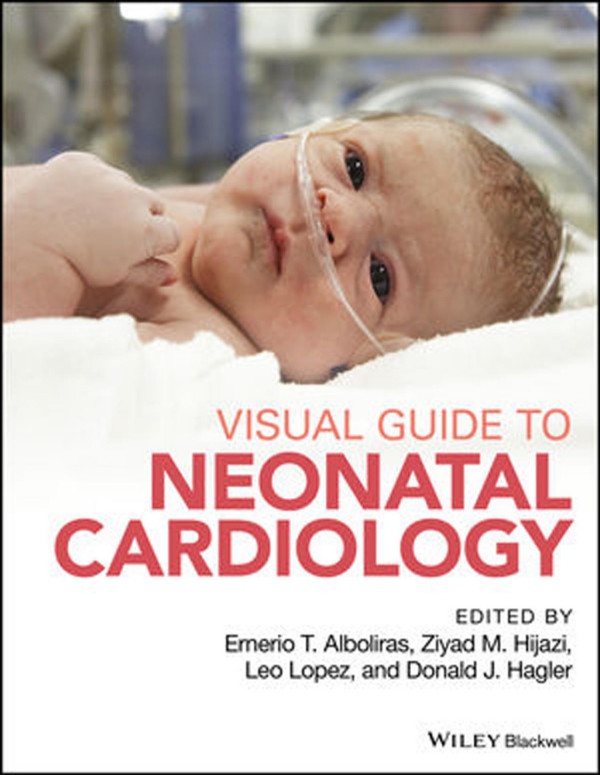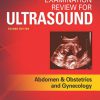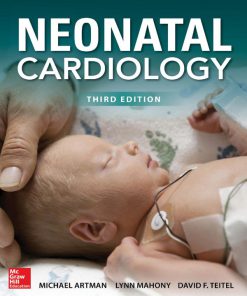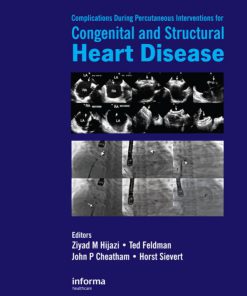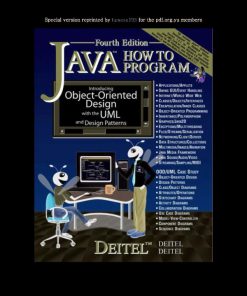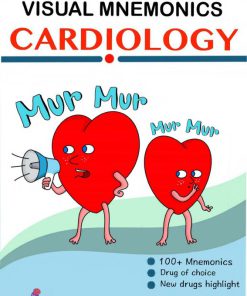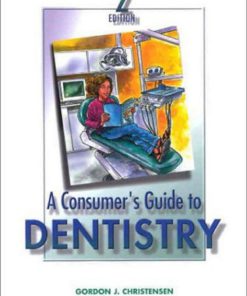Visual Guide to Neonatal Cardiology 1st Edition by Ernerio T Alboliras, Ziyad M Hijazi, Cecilio Lopez, Donald J Hagler ISBN 1118635221 9781118635223
$50.00 Original price was: $50.00.$25.00Current price is: $25.00.
Authors:Visual guide to neonatal cardiology-Wiley (2018) , Author sort:cardiology-Wiley, Visual guide to neonatal , Published:Published:Feb 2018
Visual Guide to Neonatal Cardiology 1st Edition by Ernerio T Alboliras, Ziyad M Hijazi, Cecilio Lopez, Donald J Hagler – Ebook PDF Instant Download/Delivery. 1118635221, 9781118635223
Full download Visual Guide to Neonatal Cardiology 1st Edition after payment
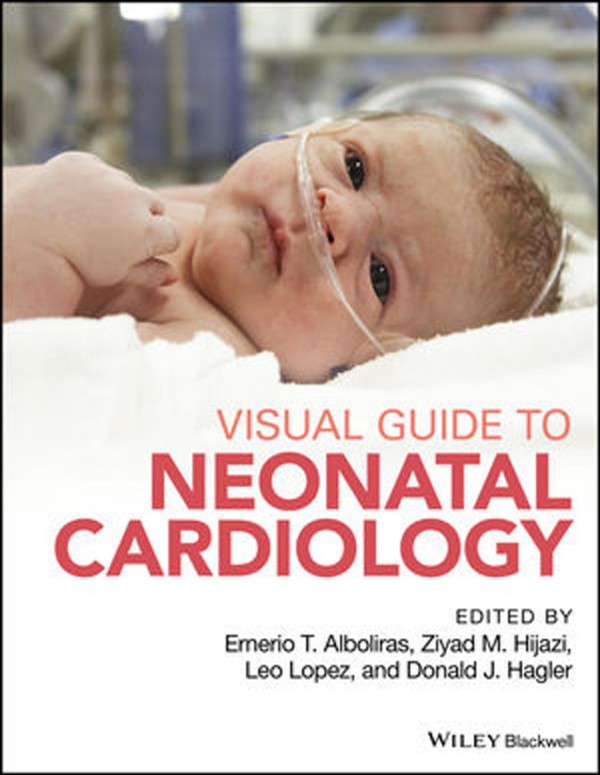
Product details:
ISBN 10: 1118635221
ISBN 13: 9781118635223
Author: Ernerio T Alboliras, Ziyad M Hijazi, Cecilio Lopez, Donald J Hagler
The Visual Guide to Neonatal Cardiology is a comprehensive, highly illustrated, reference covering the evaluation, diagnosis and management of cardiac disease in the newborn. Contains over 900 color illustrations, including patient photographs, chest roentgenograms, electrocardiograms, echocardiograms, angiocardiograms, 3D computed tomogramphy, magnetic resonance imaging, pathologic specimens, and other relevant visual aids Discusses the natural history of fetal heart disease and the rationale, indications, technique, and impact of fetal cardiac intervention Reviews the anatomy and physiology of the neonatal cardiovascular system, including differences within the fetal, transitional, neonatal, child and adult circulatory system Highlights key steps for taking a patient history, including detailed discussion of the cardiac examination (inspection, palpation and auscultation of heart sounds and murmurs) Presents over 35 morphologic conditions with sections covering introduction, epidemiology, etiology with accepted or postulated embryogenesis, pathophysiology, clinical presentation, physical examination findings, diagnostic evaluation, management, and prognosis Includes a neonatal formulary reviewing selected medications currently used for treatment of perioperative low cardiac output, congestive heart failure, pulmonary hypertension, sedation, pain and anticoagulation in neonates.
Visual Guide to Neonatal Cardiology 1st Table of contents:
Part I: Prenatal and Perinatal Issues
Chapter 1: Cardiac Embryology and Embryopathy
Initial Stages of Development
Looping of the Heart Tube
The Process of Ballooning
Formation of the Atrial Chambers
Atrial Septation
Ventricular Development
Development and Maldevelopment of the Outflow Tract
Development of the Coronary Circulation
Acknowledgments
References
Chapter 2: Maternal, Familial, and Non-Cardiac Fetal Conditions Affecting the Fetal and Neonatal Heart
Maternal Factors
Twins
Familial
Non-cardiac Fetal Conditions
References
Chapter 3: The Natural and Unnatural History of Fetal Heart Disease
References
Part II: General Neonatal Issues
Chapter 4: Epidemiology of Heart Defects
Prevalence of Individual Lesions
Changes in Prevalence Over Time
Regional and Racial Variation
Impact of Fetal Testing
Non-Genetic Risk Factors
References
Chapter 5: The Transitional and Neonatal Heart and Cardiovascular System
Birth and Neonatal Period
Acknowledgment
References
Chapter 6: History and Physical Examination
History
Physical Examination
Further Reading
Chapter 7: The Cyanotic Newborn
Reference
Further Reading
Chapter 8: The Tachypneic Newborn
Reference
Further Reading
Chapter 9: The Hypoperfused Newborn
Etiology
History
Physical Examination
Diagnostic Tests
Management
Further Reading
Chapter 10: The Dysmorphic Newborn
Further Reading
Part III: Diagnostic Procedures
Chapter 11: Chest Roentgenogram
Pulmonary Vascularity
Cardiomegaly
Situs
Great Vessels
Extracardiac Evaluation
Lines and Tubes in Patients With Congenital Heart Disease
Complications
Chapter 12: Electrocardiogram
ECG Leads
Basic ECG Setup
Wave Morphologies
ECG Intervals
Heart Rate
Cardiac Rhythm
Axis
Right-sided Chest Leads
Abnormalities on the ECG
Further Reading
Chapter 13: Echocardiogram
History
Physics
Performance of a Pediatric Echocardiogram
References
Chapter 14: Cardiac Catheterization and Angiocardiography
Patent Ductus Arteriosus (Figures 14.1 and 14.2)
Pulmonary Valve Stenosis (Figure 14.3)
Critical Aortic Valve Stenosis (Figure 14.4)
Coarctation of the Aorta (Figure 14.5)
Major Aorto-Pulmonary Collateral Arteries (Figure 14.6)
Transposition of the Great Arteries (Figure 14.7)
Hypoplastic Left Ventricle (Figure 14.8)
Total Anomalous Pulmonary Venous Connection (Figure 14.9)
Rotational Angiography (Figure 14.10)
References
Chapter 15: Computed Tomography
Scanning Technique for Cardiac CTA in Neonates
Advantages of Cardiac CTA Over Other Imaging Modalities
Postprocessing of Cardiac CTA
Further Reading
Chapter 16: Magnetic Resonance Imaging
Indications for Neonatal CMR
References
Chapter 17: Electrophysiologic Testing, Transesophageal Pacing and Pacemakers
Pacemakers
Implantable Cardioverter-Defibrillators
Electrophysiology Studies
Transesophageal and Temporary Pacing
Reference
Part IV: Specific Morphologic Conditions
Chapter 18: Total Anomalous Pulmonary Venous Connection
Definition
Etiology
Embryologic Basis
Anatomy
Pathophysiology
Total Anomalous Pulmonary Venous Drainage
Treatment
References
Chapter 19: Other Anomalies of Pulmonary and Systemic Venous Connections
Achnowledgment
References
Chapter 20: Anomalies of Atrial Septation
Background and Anatomy
Neonatal Presentation
Management and Treatment Options
References
Chapter 21: Atrial Chamber Obstruction
Cor Triatriatum Sinister
Cor Triatriatum Dexter
References
Chapter 22: Common Atrioventricular Canal Defects
Pathophysiology
Clinical Manifestation
Investigations
Management
References
Chapter 23: Ventricular Septal Defect
Pathophysiology
Clinical Presentation and Diagnosis
Nomenclature and Anatomy
Management
References
Chapter 24: Tricuspid Atresia
Anatomy
Physiology
Physical Examination
Electrocardiogram
Chest X-Ray
Echocardiography
Cardiac Catheterization
Preoperative Management
Surgical Management
Postoperative Management
References
Chapter 25: Ebstein Malformation and Tricuspid Valve Dysplasias
Ebstein Malformation
Tricuspid Valve Dysplasia
References
Chapter 26: Pulmonary Valve and Pulmonary Arterial Stenosis
Pulmonary Valve Stenosis
Pulmonary Arterial Stenosis
References
Chapter 27: Pulmonary Atresia with Intact Ventricular Septum
Embryology
Pathology
Physical Examination
Chest X-ray
Electrocardiography
Echocardiography
Cardiac Catheterization
Medical Therapy
Surgery
Transcatheter Therapy
Outcomes
Conclusions
References
Chapter 28: Tetralogy of Fallot with Pulmonary Stenosis or Atresia
Tetralogy of Fallot with Pulmonary Stenosis
Pulmonary Valve Atresia with Ventricular Septal Defect (Tetralogy of Fallot with Pulmonary Atresia)
Further Reading
Chapter 29: Absent Pulmonary Valve
References
Chapter 30: Transposition of the Great Arteries
References
Chapter 31: Congenitally Corrected Transposition of the Great Arteries
Morphology and Associated Lesions
Clinical Presentation
Outcomes and Interventions
References
Chapter 32: Common Arterial Trunk (Truncus Arteriosus)
References
Chapter 33: Mitral Valve Apparatus Abnormalities
Normal Mitral Valve Complex
Embryology
Abnormalities of Mitral Valve Apparatus
Conclusions
References
Chapter 34: Hypoplastic Left Heart Syndrome
Anatomy
Physiology
Diagnosis
Management
Prognosis
References
Chapter 35: Aortic Stenosis
Aortic Valve Stenosis
Subaortic Stenosis
References
Further Reading
Chapter 36: Coronary Artery Anomalies
References
Chapter 37: Aorto-Left Ventricular Tunnel
Aorto-Left Ventricular Tunnel: Anatomic Characteristics
Associated Anomalies
Clinical Presentation
Diagnostic Methods
Management
Conclusions
References
Chapter 38: Coronary Cameral Fistulas
Definition
Etiology
Pathophysiology and Natural History
Diagnosis
Management Strategies
Interventional Catheterization
Surgical Therapy
Conclusions
References
Chapter 39: Aortopulmonary Window
Reference
Further Reading
Chapter 40: Anomalous Origin of a Branch Pulmonary Artery From the Ascending Aorta (Hemitruncus)
Further Reading
Chapter 41: Interrupted Aortic Arch
References
Chapter 42: Coarctation of the Aorta
Pathophysiology
Clinical Manifestation
Investigations
Management
References
Chapter 43: Vascular Rings and Pulmonary Slings
Anomalies of the Aortic Arch
Vascular Rings
Anomalous Subclavian Artery (Kommerell diverticulum)
Diagnosis
Pulmonary Artery Slings
References
Chapter 44: Double Outlet Right Ventricle
Acknowledgments
References
Chapter 45: Double Outlet Left Ventricle
Etiology
Morphology
Pathophysiology
Surgical Repair
Long-term Outcomes
References
Chapter 46: Single Ventricle and Biventricular Hearts with Hypoplasia of One Ventricle
Embryology and Genetics
Prenatal Circulation
Postnatal Circulation and Clinical Presentation
Preoperative Evaluation
Management
Surgical Strategies
Outcomes
Conclusions
References
Chapter 47: Dextrocardia and the Heterotaxy Syndromes
Heterotaxy Syndrome
Definitions
Associated Non-Cardiac Anomalies
Associated Cardiac Anomalies
Management
Outcomes
Conclusions
References
Chapter 48: Ectopia Cordis and Thoracopagus Twins
Ectopia Cordis
Thoracopagus Twins
References
Chapter 49: Patent Ductus Arteriosus
Clinical Findings
Imaging
Management
References
Chapter 50: Neonatal Hypertrophic Cardiomyopathy and Syndromes with Infantile Cardiac Hypertrophy
Hypertrophic Cardiomyopathy
Common Causes of Cardiac Hypertrophy in Neonates
Characteristics of Neonatal HCM and Syndromes with Concomitant Cardiac Hypertrophy
Genetics of Neonatal HCM, Noonan Syndrome, and Pompe Disease
Survival and Outcomes in Neonatal HCM and Syndromes with Concomitant LVH
Conclusions
References
Chapter 51: Dilated Cardiomyopathy and Myocarditis
Etiology
Presentation
Testing
Neonatal Myocarditis
References
Chapter 52: Cardiac Chamber Aneurysms and Diverticula
Ventricular Diverticula and Aneurysms
Atrial Diverticula and Aneurysms
References
Chapter 53: Cardiac Tumors
Cardiac Rhabdomyoma
Intrapericardial Teratoma
Fibromas
Cardiac Hemangioma
References
Chapter 54: Arteriovenous Malformations
Intracranial
Extracranial Arteriovenous Malformations
Conclusions
Acknowledgement
References
Chapter 55: Pericardial Defects
Manifestations
Diagnosis
Treatment
Ectopia Cordis
Treatment
References
Chapter 56: Miscellaneous Chest Abnormalities Affecting the Heart: Diaphragmatic Hernia and Eventration; Congenital Cystic Adenomatoid Malformation of the Lung
Diaphragmatic Hernia
Eventration and Diaphragm Paresis
Congenital Cystic Adenomatoid Malformation of the Lung (Congenital Pulmonary Airway Malformation)
References
Chapter 57: Persistent Pulmonary Hypertension of the Newborn
Circulatory Pathophysiology
Diagnostic Work-up
Management Considerations
Conclusions
References
Chapter 58: Hydrops Fetalis
Presentation
Causes
Evaluation
Treatment
Maternal Complications
Prognosis
Fetal Hydrops for the Perinatal Cardiologist
Counseling
Antepartum
Delivery
CV Profile Score in Hydrops
Cardiomegaly
Abnormal Myocardial Function
Arterial Doppler Redistribution of Fetal Cardiac Output
Cardiovascular Profile Score
Conclusions
References
Part V: Rhythm Disturbances in the Newborn
Chapter 59: Structural, Metabolic, and Genetic Abnormalities Affecting the Neonatal Conduction System
References
Chapter 60: Tachydysrhythmias
Supraventricular Tachycardia
Ventricular Tachydysrhythmias
References
Chapter 61: Bradydysrhythmias
Diagnosis of Abnormal Atrioventricular Conduction
Etiologies of Abnormal Atrioventricular Conduction
Inherited Causes of Bradycardia
Non-Cardiac Causes of Bradycardia
Evaluation
Management
Conclusions
References
Chapter 62: Atrial and Ventricular Ectopies
Premature Atrial Contractions
Clinical Presentation
Evaluation
Management
Premature Ventricular Contractions
Clinical Presentation
Evaluation
Management
References
Part VI: Special Issues in the Newborn
Chapter 63: Balloon Atrial Septostomy
References
Chapter 64: Interventional Therapeutic Procedures in the Newborn
Opening of Atrial Communication
Transcatheter Balloon Dilation of Cardiac Valves
Balloon Angioplasty and/or Stent Placement
PDA Stenting
Transcatheter Vascular Occlusion
Closure of Intracardiac Communications (ASD, VSD)
References
Chapter 65: The Hybrid Procedure
Hybrid Palliation of Hypoplastic Left Heart Syndrome
Creating a Non-Restrictive Atrial Communication
Perventricular Closure of Ventricular Septal Defects
Hybrid Balloon Aortic or Pulmonary Valvuloplasty
References
Chapter 66: Neonatal Cardiac Surgical Procedures
Hypoplastic Left Heart Syndrome (Figure 66.1)
Transposition of the Great Arteries (Figure 66.5)
Systemic to Pulmonary Artery Shunt (Figure 66.9)
Neonatal Repair of Coarctation
Total Anomalous Pulmonary Venous Connection
Interrupted Aortic Arch (Figures 66.20 and 66.21)
Truncus Arteriosus (Figures 66.22, 66.23, 66.24, and 66.25)
Patent Ductus Arteriosus (Figures 66.26 and 66.27)
Chapter 67: Extracorporeal Membrane Oxygenation and Ventricular Assist Devices
Indications for Circulatory Support
Types of Mechanical Circulatory Support Devices
Management During Circulatory Support
Experience with Berlin Heart EXCOR
Conclusions
The Future
References
Chapter 68: Neonatal Cardiac Transplantation
History
Demographics of Transplant
Epidemiology
Post-Transplant Survival
Quality of Life
Immunosuppression
Morbidity
Waitlist Mortality
Benefits
Transplantation and Hypoplastic Left Heart Syndrome
Heart Transplant Technique
Conclusions
References
Chapter 69: Postoperative Care of the Newborn
General Principles
Inotropic Support of the Postoperative Patient
Mechanical Support of the Failing Heart After Surgery
Sedation, Analgesia, and Neuromuscular Blockade
Postoperative Arrhythmias
Special Considerations
Issues on Postoperative Care in the Newborn for Specific Lesions (see also chapters on specific cardiac defects)
Part VII: Neonatal Formulary
Chapter 70: Drugs
Further Reading
Chapter 71: Nutrition
Stress Response to Surgery or Shock
Metabolic Needs in Uncorrected CHD
People also search for Visual Guide to Neonatal Cardiology 1st:
visual guide to neonatal cardiology
visual guide to neonatal cardiology pdf
neonatal cardiologist salary
neonatal care guidelines
visual guide to ecg interpretation pdf
You may also like…
eBook PDF
Consumer Guide to Dentistry 2nd Edition by Gordon J Christensen ISBN 0323014836 9780323014830

